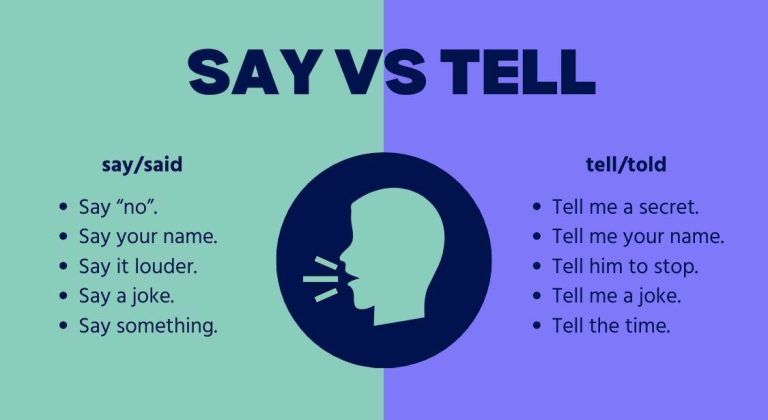Say vs Tell: What’s the Difference?

“Say” and “tell” are both verbs we use for communication. But, we use them differently. “Say” focuses on the words spoken. For example, “He said hello.” “Tell” needs someone to receive the info, like “She told me a story.”
In grammar, “tell” requires a listener, but “say” needs no direction.”
Examples of “Say”
Using “say” is all about expressing words or phrases. It fits into many contexts without needing a specific listener mentioned.
Here are some examples of using “say” in sentences:
1. “Say no” is about refusing or declining something. It’s a way to show disagreement.
2. “Say yes” means to agree or accept something. It shows willingness or approval.
3. “Say hello” is a friendly greeting. It’s how you acknowledge someone or start a conversation.
4. “Say please” is about being polite. We use it to show good manners.
5. “Say goodbye” is used when leaving or parting ways with someone. It’s a way to express farewell.
6. “Say something” encourages someone to speak up. We use it when we want to hear someone’s thoughts or feelings.
Each use of “say” fits different situations. For example, they can make our conversations clearer and more polite.
“Say” is often followed by the exact words you speak. So, it’s great for quoting someone and sharing words or phrases.
Examples of “Tell”
Using “tell” is about giving information or instructions to someone. For instance, you might tell a friend a story or tell a child to clean their room.
Here are the different cases that you might use “tell”:
1. “Tell a lie” means to say something that isn’t true to someone. People often lie to avoid trouble.
2. “Tell a joke” is when you share a funny story or a punchline with someone to make them laugh.
3. “Tell a story” involves sharing a series of events, real or imagined.
4. “Tell a secret” means sharing information that is meant to be kept hidden, usually with someone you trust.
5. “Tell the truth” is when you share facts or information exactly as they are, without hiding anything.
6. “Tell somebody” involves directing your words or message to a specific person.
Unlike “say,” “tell” requires a person who receives the message. So, “tell” is all about conveying something to someone else. Whether it’s a fact, a fib, or a funny tale, using “tell” makes sure your message reaches someone directly.
Say/Said/Said vs Tell/Told/Told
Verb conjugation changes the form of a verb to show different times of the action. Let’s look at “say” and “tell.”
For “say,” the forms are:
- Say (present tense): “I say hello every morning.”
- Said (past tense): “Yesterday, I said goodbye.”
- Said (past participle): “I have said my piece.”
With “tell,” it goes like this:
- Tell (present tense): “I tell stories to my friends.”
- Told (past tense): “Last night, I told a joke.”
- Told (past participle): “I have told you everything.”
Both “say” and “tell” keep the past and past participle the same.
“Say” vs “Tell”
Both “say” and “tell” are for communication, but we use them differently.
“Say” focuses on the words themselves, without necessarily having a direct listener. It’s great for quoting or stating.
On the other hand, “tell” involves a receiver. We use it for giving information and instructions. It’s also for sharing stories directly with someone.
